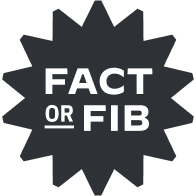Which finger has its own pulse?
Sunday, June 16, 2024
 Make every day more interesting. Each day a surprising fact opens a world of fascinating information for you to explore. Did you know that….?
Make every day more interesting. Each day a surprising fact opens a world of fascinating information for you to explore. Did you know that….? 









| | Original photo by PeopleImages/ Shutterstock |
| Thumbs have their own pulse. | If you've ever seen someone track their pulse (in real life or on a crime drama), you'll notice that the index and middle fingers are always pressed on the neck's carotid artery, which is responsible for transporting blood to the brain. There's a reason why doctors (and actors who play doctors on TV) use these fingers and not, say, their thumbs. While your thumb is good for many things, taking your pulse isn't one of them. Unlike the other four digits, the thumb has its own exclusive artery, the princeps pollicis, which makes it biologically unreliable as a pulse reader — because you'll feel it pulse instead of the artery in your neck.
Among the 34 muscles, 29 bones, and three major nerves in the hand, there are also two key arteries supplying blood to the area: the ulnar and the radial. The ulnar artery branches at the wrist into a network of blood supply vessels called the superficial palmar arch, which then branches to supply blood to the top four fingers. The radial artery, meanwhile, branches at the wrist into the deep palmer arch, which then branches into the princeps pollicis artery, sending blood to the thumb. Regardless, today there are more modern methods of tracking your pulse that use technology in lieu of touch. The Apple Watch, one of the most popular consumer fitness-tracking devices, relies on a process called "photoplethysmography," which leverages the fact that blood reflects red light and absorbs green light. The watch uses green LED lights that flash hundreds of times per second, as well as light-sensitive photodiodes that help measure the amount of green-light absorption, and thus blood flow and pulse — no fingers (and definitely no thumbs) required.
|
|
 | | Today's "thumbs up" gesture comes from ancient Rome. | | |
|
|
| Today's "thumbs up" gesture comes from ancient Rome. |  |  |
|
|
|
|
|
| The World Thumb Wrestling Championships are held every year in __. |  |
|
|
 | Numbers Don't Lie |
|
 | | Beats per minute of a pygmy shrew's heart, the fastest pulse of any mammal | | 1,200 |
|
|  | | Number of times a human heart beats per year, on average | | 35 million |
|
|
|
 | | Rough number of years ago the opposable thumb evolved in early human ancestors | | 2 million |
|
|  | | Release year of "Thumb Wars," a parody film that replaces "Star Wars" characters with thumbs | | 1999 |
|
|
|
|
|
 | Thumbs gave humans a significant evolutionary advantage. |
|
| Of the many biological advantages human evolution has brought us, two of the biggest are our brains and our thumbs. While the utility of our brain is pretty obvious, it's our opposable thumbs that do much of the work of day-to-day life. In fact, some scientists credit our thumbs as a driving force behind human culture. Around 3 million years ago, early hominids such as Australopithecines used primitive tools — basically just sticks and rocks — and possessed hands similar to a chimp's. A million years later, as our early ancestors began migrating out of Africa, increased manual dexterity thanks to improved opposable thumbs gave rise to more complex culture, because of the variety of tools these early species could now manipulate. Eventually, starting some 300,000 years ago or so, Homo sapiens began grasping all the tools that make modern life possible — whether a philosopher's quill, a carpenter's hammer, a warrior's weapon, or a TikToker's iPhone. | | |
|
|
|
|
|


posted by June Lesley at 5:30 AM


![]()
![]()
![]()
![]()
0 Comments:
Post a Comment
<< Home